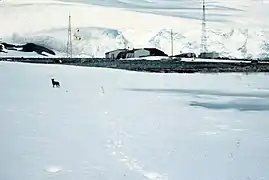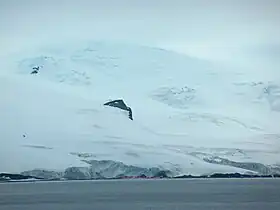Prat Station
Base Naval Antártica "Arturo Prat" | |
|---|---|
| Arturo Prat Station | |
.jpg.webp) Base Naval Antártica "Arturo Prat" | |
 Flag | |
 Prat Station Location of Prat Station in Antarctica | |
| Coordinates: 62°28′44″S 59°39′52″W / 62.478889°S 59.664444°W | |
| Country | |
| Location in Antarctica | Iquique Cove Greenwich Island South Shetland Islands |
| Administered by | |
| Established | 6 February 1947 |
| Named for | Arturo Prat |
| Elevation | 0 m (0 ft) |
| Population (2017)[1] | |
| • Summer | 30 |
| • Winter | 8 |
| UN/LOCODE | AQ APT |
| Type | All-year round |
| Period | Annual |
| Status | Operational |
| Activities | Ionospheric and meteorologic research |
| Website | Base Arturo Prat INACH |
Captain Arturo Prat Base (Spanish: Base Naval Antártica "Arturo Prat") is a Chilean Antarctic research station located at Iquique Cove, Greenwich Island in the South Shetland Islands, Antarctica.
Opened February 6, 1947 by the First Chilean Antarctic Expedition, it is the oldest Chilean Antarctic station. Until March 1, 2006, it was a base of the Chilean Navy, on which date it was handed over to the regional government of Magallanes and Antártica Chilena Region. Until February 2004, it had been a permanent base. Afterwards, it had served as a summer base for ionospheric and meteorologic research. There have been plans to reopen the station for permanent occupation starting March 2008. The base is named for Captain Arturo Prat, a Chilean naval officer.
Historic sites
- A concrete monolith was erected in 1947 near the base as a point of reference for Chilean Antarctic hydrographic surveys. It represents an important pre-IGY activity in Antarctica, and is preserved and maintained by personnel from the base. It has been designated a Historic Site or Monument (HSM 32), following a proposal by Chile to the Antarctic Treaty Consultative Meeting.[2]
- A shelter and cross with plaque was erected near the base and named after Lieutenant Commander González Pacheco, who died in 1960 while in charge of the station. It commemorates events related to a person whose role and the circumstances of his death have both symbolic and educational value relating to human activities in Antarctica. It has been designated a Historic Site or Monument (HSM 33), following a proposal by Chile to the Antarctic Treaty Consultative Meeting.[2]
- A bust of Chilean naval hero Arturo Prat was erected at the base in 1947. It represents pre-IGY activities and has symbolic value relating to Chilean presence in Antarctica. It has been designated a Historic Site or Monument (HSM 34), following a proposal by Chile to the Antarctic Treaty Consultative Meeting.[2]
- A wooden cross and statue of the Virgin of Carmel was erected in 1947 near the base. It represents pre-IGY activities and has both symbolic and architectural value. It has been designated a Historic Site or Monument (HSM 35), following a proposal by Chile to the Antarctic Treaty Consultative Meeting.[2]
Climate
The climate is maritime polar (Köppen: ET), being on the coast of the peninsula with less severe averages than expected in Antarctica.[3][4] Extreme temperatures can reach −29 °C or −20.2 °F in July, which is still quite bearable to humans protected due to considerable moderation of the sea, and a rare heat wave caused the temperature to reach 19 °C or 66.2 °F, a relatively high value. The climate is quite humid for its location and precipitation is fairly well distributed, so that even in the driest months it receives more precipitation than almost all of the Mediterranean zone.[5]
| Climate data for Captain Arturo Prat Base, elevation: 5 m or 16 ft, 1991–2020 normals, extremes 1958-present[lower-alpha 1] | |||||||||||||
|---|---|---|---|---|---|---|---|---|---|---|---|---|---|
| Month | Jan | Feb | Mar | Apr | May | Jun | Jul | Aug | Sep | Oct | Nov | Dec | Year |
| Record high °C (°F) | 8.4 (47.1) |
13.0 (55.4) |
9.1 (48.4) |
5.0 (41.0) |
5.8 (42.4) |
4.2 (39.6) |
3.9 (39.0) |
3.5 (38.3) |
4.9 (40.8) |
5.4 (41.7) |
6.3 (43.3) |
9.7 (49.5) |
13.0 (55.4) |
| Mean daily maximum °C (°F) | 3.4 (38.1) |
3.4 (38.1) |
2.2 (36.0) |
0.5 (32.9) |
−1.0 (30.2) |
−2.9 (26.8) |
−3.4 (25.9) |
−3.3 (26.1) |
−2.1 (28.2) |
−0.6 (30.9) |
0.8 (33.4) |
2.3 (36.1) |
−0.1 (31.8) |
| Daily mean °C (°F) | 1.9 (35.4) |
1.8 (35.2) |
0.7 (33.3) |
−1.1 (30.0) |
−2.9 (26.8) |
−5.2 (22.6) |
−6.0 (21.2) |
−5.8 (21.6) |
−4.6 (23.7) |
−2.5 (27.5) |
−0.6 (30.9) |
0.8 (33.4) |
−2.0 (28.4) |
| Mean daily minimum °C (°F) | 0.4 (32.7) |
0.3 (32.5) |
−0.9 (30.4) |
−2.7 (27.1) |
−4.7 (23.5) |
−7.4 (18.7) |
−8.5 (16.7) |
−8.3 (17.1) |
−7.0 (19.4) |
−4.4 (24.1) |
−2.2 (28.0) |
−0.7 (30.7) |
−3.8 (25.2) |
| Record low °C (°F) | −6.2 (20.8) |
−7.2 (19.0) |
−15.2 (4.6) |
−18.0 (−0.4) |
−24.8 (−12.6) |
−21.8 (−7.2) |
−30.0 (−22.0) |
−26.2 (−15.2) |
−26.0 (−14.8) |
−19.0 (−2.2) |
−12.2 (10.0) |
−7.0 (19.4) |
−30.0 (−22.0) |
| Average precipitation mm (inches) | 75.0 (2.95) |
72.7 (2.86) |
80.1 (3.15) |
72.2 (2.84) |
60.8 (2.39) |
49.1 (1.93) |
43.5 (1.71) |
40.8 (1.61) |
49.9 (1.96) |
61.5 (2.42) |
52.6 (2.07) |
55.6 (2.19) |
708.9 (27.91) |
| Average precipitation days (≥ 1.0 mm) | 10 | 12 | 15 | 10 | 8 | 10 | 7 | 10 | 12 | 12 | 15 | 11 | 132 |
| Average relative humidity (%) | 86.8 | 87.0 | 88.2 | 88.2 | 88.4 | 88.7 | 89.1 | 88.7 | 88.4 | 88.0 | 87.0 | 85.7 | 87.7 |
| Source 1: Dirección Meteorológica de Chile[6][7][8] | |||||||||||||
| Source 2: DWD (precipitation days 1961–1990)[9] | |||||||||||||
Maps

- L.L. Ivanov et al. Antarctica: Livingston Island and Greenwich Island, South Shetland Islands. Scale 1:100,000 topographic map. Sofia: Antarctic Place-names Commission of Bulgaria, 2005.
- L.L. Ivanov. Antarctica: Livingston Island and Greenwich, Robert, Snow and Smith Islands. Scale 1:120,000 topographic map. Troyan: Manfred Wörner Foundation, 2010. ISBN 978-954-92032-9-5 (First edition 2009. ISBN 978-954-92032-6-4)
- Antarctic Digital Database (ADD). Scale 1:250000 topographic map of Antarctica. Scientific Committee on Antarctic Research (SCAR). Since 1993, regularly upgraded and updated.
Gallery
 Location of Greenwich Island in the South Shetland Islands
Location of Greenwich Island in the South Shetland Islands View of base in 1957
View of base in 1957
See also
Notes
- ↑ Although there are several gaps (periods without data) that compromise the historical series. Days of precipitation are only 1983-1990
References
- 1 2 Antarctic Station Catalogue (PDF) (catalogue). Council of Managers of National Antarctic Programs. August 2017. p. 51. ISBN 978-0-473-40409-3. Archived (PDF) from the original on 22 October 2022. Retrieved 16 January 2023.
- 1 2 3 4 "List of Historic Sites and Monuments approved by the ATCM (2012)" (PDF). Antarctic Treaty Secretariat. 2012. Retrieved 2013-12-30.
- ↑ "World Maps of Köppen-Geiger climate classification". koeppen-geiger.vu-wien.ac.at. Retrieved 2019-07-22.
- ↑ "What happens to Steig et al's warming when you divide Antarctica into two distinct climate zones?". Watts Up With That?. 2009-04-18. Retrieved 2019-07-22.
- ↑ "Base Arturo Prat Climate History". Weather2. Retrieved July 22, 2019.
- ↑ "Climatología de Estaciones Chilenas de la Península Antártica" (PDF) (in Spanish). Dirección Meteorológica de Chile. Archived from the original (PDF) on 30 May 2023. Retrieved 30 May 2023.
- ↑ "Temperaturas Medias y Extremas en 30 Años-Entre los años: 1991 al 2020-Nombre estación: Arturo Prat, Antártica" (in Spanish). Dirección Meteorológica de Chile. Archived from the original on 30 May 2023. Retrieved 30 May 2023.
- ↑ "Temperatura Histórica de la estación C.M.A. Arturo Prat, Base Antártica (950002)" (in Spanish). Dirección Meteorológica de Chile. Archived from the original on 30 May 2023. Retrieved 30 May 2023.
- ↑ "Klimatafel n Basis "Arturo Prat" (Chile) / Antarktis" (PDF). Baseline climate means (1961–1990) from stations all over the world (in German). Deutscher Wetterdienst. Retrieved July 22, 2019.
.svg.png.webp)